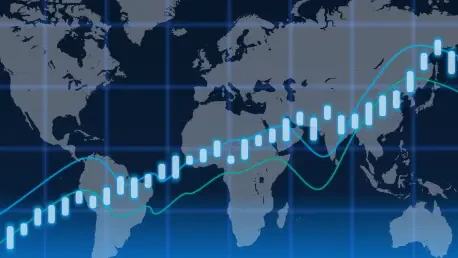In an era defined by rapid globalization, the intricate web of international markets is facing unprecedented challenges that threaten economic stability on a massive scale, compounded by geopolitical unrest marked by ongoing conflicts and trade uncertainties. Alongside the escalating impacts of climate change, these issues are creating a turbulent environment where commodity prices swing dramatically across sectors like energy, agriculture, and metals. These disruptions are not merely isolated events but interconnected forces that ripple through supply chains, inflation rates, and consumer costs worldwide. From late 2024 to September of this year, the volatility in global markets has been starkly evident, with projections into 2026 painting a picture of continued uncertainty. This article aims to dissect the myriad factors driving these fluctuations, exploring how specific industries are navigating the storm while others falter under pressure. By delving into the sharp contrasts between soaring natural gas prices and declining crude oil values, or the record highs of precious metals like gold, a clearer understanding emerges of the broader economic implications. The stakes are high as central banks grapple with policy responses, and the looming energy transition promises to reshape demand dynamics for decades. As these forces collide, the global economy stands at a critical juncture, demanding attention to both immediate risks and long-term structural shifts.
Forces Behind Market Turbulence
Regional Conflicts and Trade Uncertainties
The persistent shadow of geopolitical strife continues to destabilize global commodity markets, with conflicts such as the Russia-Ukraine war serving as a primary catalyst for uncertainty, disrupting vital supply chains. This ongoing turmoil particularly affects energy resources like crude oil and natural gas, as well as agricultural staples that depend on stable trade routes. Middle Eastern tensions further exacerbate the situation, threatening key maritime pathways and sustaining fears of supply shortages. These events contribute to erratic price movements, often inflating costs as markets react to perceived risks rather than actual disruptions. Beyond direct conflict, potential trade policies, including tariffs and sanctions, add another layer of complexity, making it difficult for businesses to predict costs and plan effectively. The resulting volatility is a persistent challenge, keeping inflationary pressures alive and forcing industries reliant on these commodities to adapt swiftly to an ever-shifting landscape.
Another dimension of this geopolitical strain lies in its impact on investor sentiment and market confidence, which can be just as disruptive as physical supply issues, creating ripples across global economies. When major powers clash or hint at restrictive trade measures, markets often preemptively adjust, leading to price spikes in essential goods even before tangible shortages occur. Energy markets, for instance, feel the immediate brunt as fears over disrupted oil shipments push prices upward temporarily, only to fall again when tensions ease or alternative supplies are secured. Agricultural goods face similar speculative pressures, especially in regions dependent on imports from conflict zones. This unpredictability not only affects pricing but also influences long-term investment decisions, as companies hesitate to commit to projects in volatile regions, further compounding the economic uncertainty that defines the current market environment.
Environmental Challenges and Supply Constraints
Climate change has emerged as a formidable disruptor, with extreme weather events like El Niño creating significant supply bottlenecks for agricultural commodities across critical producing regions. Countries such as Brazil and Vietnam, major exporters of coffee and sugar, have faced severe droughts and erratic weather patterns, leading to reduced yields and sharp price surges. These shortages are not just numbers on a balance sheet; they translate into real concerns about global food security, especially for nations reliant on imported goods. The increasing frequency of such climate shocks signals a troubling trend, where traditional farming cycles are upended, and market participants must contend with heightened unpredictability. As a result, prices for soft commodities have skyrocketed, placing additional burdens on consumers and businesses already grappling with economic slowdowns.
Beyond immediate agricultural impacts, the broader implications of climate disruptions touch nearly every sector tied to natural resources, amplifying the strain on global markets and creating widespread economic challenges. Energy production, for instance, faces challenges when hydroelectric output drops due to drought or when extreme storms disrupt oil and gas infrastructure. Industrial metals mining operations are similarly affected, with floods or heatwaves delaying production schedules and inflating costs. These cascading effects highlight the interconnectedness of climate risks and economic stability, pushing policymakers to consider more resilient supply chain strategies. The urgency to address these environmental challenges is clear, as sustained volatility in commodity prices driven by weather anomalies could undermine long-term economic planning and exacerbate inflationary trends, making adaptation a priority for all market stakeholders.
Economic Dynamics and Policy Responses
Central Bank Strategies and Market Reactions
Monetary policy decisions, particularly those from the U.S. Federal Reserve, play a pivotal role in shaping the trajectory of commodity prices amid a backdrop of global economic slowdown. Interest rate cuts, often implemented to stimulate growth, lower the opportunity cost of holding non-yielding assets like gold, driving significant bullish momentum in precious metals markets. As of early September this year, gold prices surpassed $3,600 per ounce, reflecting not only safe-haven demand but also expectations of continued loose monetary policy. However, while these cuts aim to bolster economic activity, they also risk fueling inflation in sectors already pressured by rising commodity costs. The delicate balance central banks must strike is evident, as reduced rates might support certain assets but fail to address broader demand declines for resources like industrial metals, where economic slowdown dampens consumption.
The ripple effects of these policy shifts extend beyond individual commodities to influence broader market dynamics, creating a complex interplay of economic signals that can be difficult to predict or control. Lower interest rates often weaken the U.S. dollar, further enhancing the appeal of commodities priced in dollars for international buyers, which can temporarily prop up prices. Yet, this comes at a time when global growth forecasts are tepid, reducing overall demand for energy and raw materials needed for manufacturing. Central banks face criticism for having limited tools to address sector-specific inflation driven by supply shocks, as their actions are more suited to demand-side adjustments. This mismatch underscores the challenge of navigating a market environment where traditional monetary levers may not fully mitigate the external pressures of geopolitics and climate, leaving commodity prices subject to persistent volatility.
Rising Costs and Inflationary Challenges
The surge in commodity prices, particularly in energy and agriculture, is a key driver of inflation, placing substantial pressure on both businesses and consumers across the globe. Natural gas prices, propelled by robust demand for U.S. LNG exports, have soared, increasing costs for utilities and energy-intensive industries. Similarly, agricultural commodities like coffee and sugar have seen dramatic price hikes due to climate-induced shortages, directly impacting retail prices and squeezing margins for companies in the food and beverage sector. These rising input costs translate into higher consumer prices, eroding purchasing power and complicating efforts to maintain economic stability. The uneven distribution of these cost pressures means some regions and industries bear a heavier burden, exacerbating global economic disparities.
Central banks are caught in a bind as they attempt to manage these inflationary trends while fostering growth, often with limited success in curbing sector-specific price rises. Unlike broad-based inflation driven by excess demand, current pressures stem largely from supply-side disruptions, which monetary policy alone cannot fully address. Fiscal constraints and geopolitical risks add further layers of difficulty, as potential trade tariffs or sanctions could amplify cost increases. For businesses, the unpredictability of input expenses necessitates strategic adjustments, such as seeking alternative suppliers or passing costs onto consumers, though the latter risks dampening demand. This inflationary environment, fueled by volatile commodity markets, remains a critical challenge, with implications for long-term economic planning and the ability of policymakers to steer a steady course through turbulent times.
Sectoral Trends and Impacts
Energy Sector Dichotomy
The energy market presents a striking contrast between different commodities, reflecting the complex interplay of supply, demand, and geopolitical forces that shape pricing and availability. Natural gas prices have surged dramatically, driven by strong global demand, particularly for U.S. LNG exports to Europe, where energy security concerns remain high. Forecasts indicate a potential 55% price increase this year, benefiting producers but straining utilities and industrial users reliant on affordable energy. Meanwhile, crude oil faces downward pressure due to oversupply, with prices expected to soften into next year despite efforts by OPEC+ to balance the market through delayed output increases. This divergence highlights the uneven impact of global economic trends, where robust demand for one resource contrasts sharply with saturation in another, creating both opportunities and challenges for market participants.
Geopolitical tensions continue to inject volatility into the energy sector, often overshadowing fundamental supply and demand dynamics with speculative fears, while conflicts in key producing regions or disruptions to critical trade routes can cause temporary price spikes in crude oil, even as long-term oversupply pressures persist. Natural gas, on the other hand, benefits from structural demand shifts as countries pivot away from coal and seek cleaner energy sources, though this is tempered by expanding LNG capacity that could lead to price drops by late next year. The resulting uncertainty affects not only energy producers but also downstream industries like manufacturing and transportation, where fuel costs are a significant operational factor. As these contrasting trends unfold, the energy sector remains a focal point of market volatility, with broader implications for inflation and economic growth worldwide.
Precious Metals Boom
Precious metals, particularly gold, are experiencing a historic rally, with prices breaking past $3,600 per ounce as of early September this year, fueled by a confluence of economic and geopolitical factors. Safe-haven demand has surged amid ongoing global uncertainties, including conflicts and a weakening U.S. dollar, making gold an attractive asset for investors seeking stability. Additionally, central bank purchases, notably from countries diversifying away from dollar reserves, have bolstered this upward trend. Silver and platinum are also seeing significant gains, reflecting a broader bullish sentiment for non-yielding assets in a low-interest-rate environment shaped by monetary easing. This momentum positions precious metals as a standout performer in an otherwise turbulent commodity landscape.
The implications of this boom extend beyond mere price appreciation, influencing both market dynamics and specific industries tied to these metals. Gold miners, for instance, are reaping substantial benefits, with companies reporting revenue and margin growth as stock indexes for the sector climb over 50% year-to-date. This contrasts sharply with other commodity sectors facing declines, highlighting the unique drivers behind precious metals’ performance. However, sustained high prices could eventually dampen physical demand in markets sensitive to cost, such as jewelry, while continuing to attract speculative investment. Projections suggest that gold prices may remain elevated or even reach new highs into next year before stabilizing, driven by persistent geopolitical risks and central bank policy expectations. This enduring strength underscores the role of precious metals as a critical hedge in times of global uncertainty.
Green Metals and Industrial Shifts
Industrial metals are navigating a split landscape, with materials essential to the energy transition, like copper, experiencing robust demand growth. Copper prices have risen 8% in the first half of this year, propelled by its critical role in electric vehicles, renewable energy infrastructure, and grid modernization. This trend points to a potential structural deficit in the coming years, as supply struggles to keep pace with the accelerating shift to sustainable technologies. In contrast, metals like nickel face persistent oversupply, largely due to increased production from countries like Indonesia, resulting in a downward price trajectory that challenges mining companies. This dichotomy within the sector reflects the uneven impact of global economic trends and policy priorities on industrial commodities.
The long-term outlook for green metals like copper, lithium, and cobalt is particularly significant, as they are poised to become strategic assets in global trade and investment frameworks, especially with the push toward sustainable energy solutions. Governments and corporations are increasingly prioritizing access to these materials, recognizing their importance in achieving carbon neutrality goals. However, short-term challenges such as economic slowdowns can temper demand for industrial metals used in traditional manufacturing, creating a complex balancing act for producers. Mining companies must navigate fluctuating prices while investing in capacity to meet future needs, often under the weight of environmental regulations and community opposition. The split performance of industrial metals underscores the transformative potential of the energy transition, even as immediate market pressures create uncertainty for stakeholders across the supply chain.
Agricultural Market Fluctuations
Agricultural commodities are caught in a whirlwind of volatility, heavily influenced by climate disruptions that create stark disparities across different products. Grains such as corn, soybeans, and wheat have seen price declines due to improved yields and reduced input costs like fertilizer and fuel, offering some relief to food processors and consumers. However, soft commodities like coffee and sugar have experienced dramatic surges, with coffee prices jumping over 70% due to El Niño-induced shortages in key regions like Brazil. These spikes raise serious concerns about affordability and access, particularly in developing economies dependent on imported agricultural goods. The unpredictability of weather patterns continues to challenge traditional market forecasting, leaving producers and buyers vulnerable to sudden shifts.
The broader economic fallout from these agricultural trends is profound, contributing to inflationary pressures that affect both retail prices and business margins, while creating challenges across the supply chain. Coffee retailers, for instance, face squeezed profitability as input costs soar, often forcing difficult decisions about passing costs onto consumers or absorbing losses. Livestock prices, particularly for cattle, remain at record highs due to reduced herd sizes, further straining food supply chains. Forecasts suggest a general decline in agricultural prices next year, but this comes with a caveat of continued volatility driven by climate events. Policymakers and industry leaders are pressed to develop more resilient agricultural systems, potentially through technological innovation or diversified sourcing, to mitigate the risks posed by environmental shocks. These fluctuations highlight the sector’s critical role in global economic stability and the urgent need for adaptive strategies.
Future Horizons and Strategic Adaptations
Sustainable Energy and Commodity Demand
The global transition to sustainable energy systems is fundamentally altering the demand landscape for commodities, marking a significant departure from traditional fuel-intensive models, and positioning metals like copper, lithium, and cobalt at the forefront of this shift. Projections indicate a potential “green supercycle” driven by their essential role in renewable energy technologies and electric vehicles. This structural change is not merely a trend but a long-term redefinition of market priorities, positioning these materials as critical to achieving environmental goals. As demand surges, supply constraints could lead to sustained price appreciation, creating opportunities for producers while challenging industries reliant on affordable access to these resources. The energy transition thus emerges as a pivotal force shaping the future of global commodity markets.
Governments and private sectors are increasingly aligning their strategies with this transformative shift, recognizing the strategic importance of securing green materials. Investments in mining and recycling technologies are accelerating to address potential shortages, while trade policies are being crafted to prioritize access to critical metals. However, this transition also introduces risks, as economic slowdowns or policy missteps could disrupt the pace of adoption for green technologies, temporarily softening demand. Over the longer horizon, spanning into the next decade, the momentum behind sustainability is expected to dominate, reshaping supply chains and investment flows. Market participants must stay attuned to technological advancements and regulatory changes that will dictate the speed and scale of this shift, ensuring they are positioned to capitalize on emerging opportunities.
Enduring Threats and Market Resilience
Geopolitical fragmentation and the intensifying impacts of climate change stand as enduring threats to global market stability, ensuring that volatility remains a constant challenge. Conflicts and trade disputes disrupt supply chains for energy and agricultural goods, while extreme weather events continue to threaten production in vulnerable regions. These risks are not transient but systemic, requiring a proactive approach from companies and policymakers to safeguard economic interests. The potential for sudden price shocks, as seen in recent energy and food markets, underscores the fragility of current systems, pushing the need for diversified sourcing and enhanced risk management practices. Addressing these persistent threats is essential to building a more resilient market framework capable of withstanding external shocks.
Strategic responses to these challenges are taking shape, with an emphasis on adaptability and foresight among market stakeholders. Businesses are exploring alternative supply routes and investing in technologies to mitigate climate impacts, such as precision agriculture or renewable energy backups for production facilities. Investors, meanwhile, are urged to monitor geopolitical flashpoints and central bank policies closely, as these factors will continue to drive short-term price movements. Over the long term, building resilience will involve collaborative efforts between governments and industries to address systemic risks, whether through international agreements on trade stability or initiatives to combat climate change. By prioritizing flexibility and innovation, the global market can better navigate the uncertainties of today while preparing for the structural shifts of tomorrow, ensuring stability in an unpredictable world.









